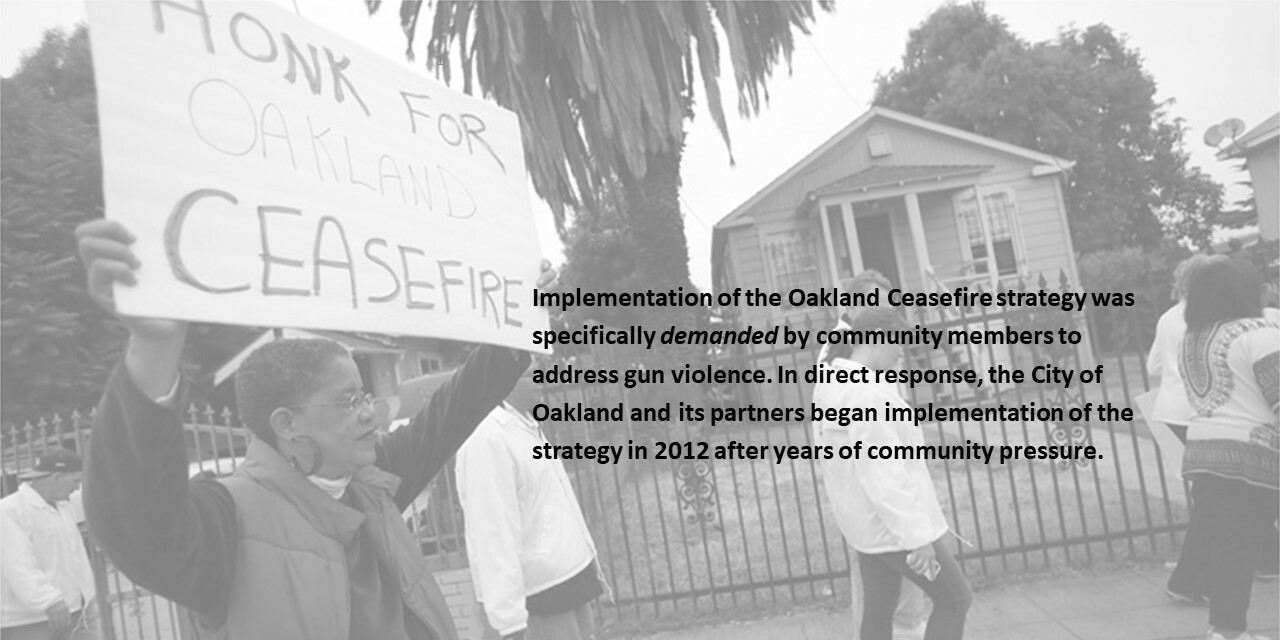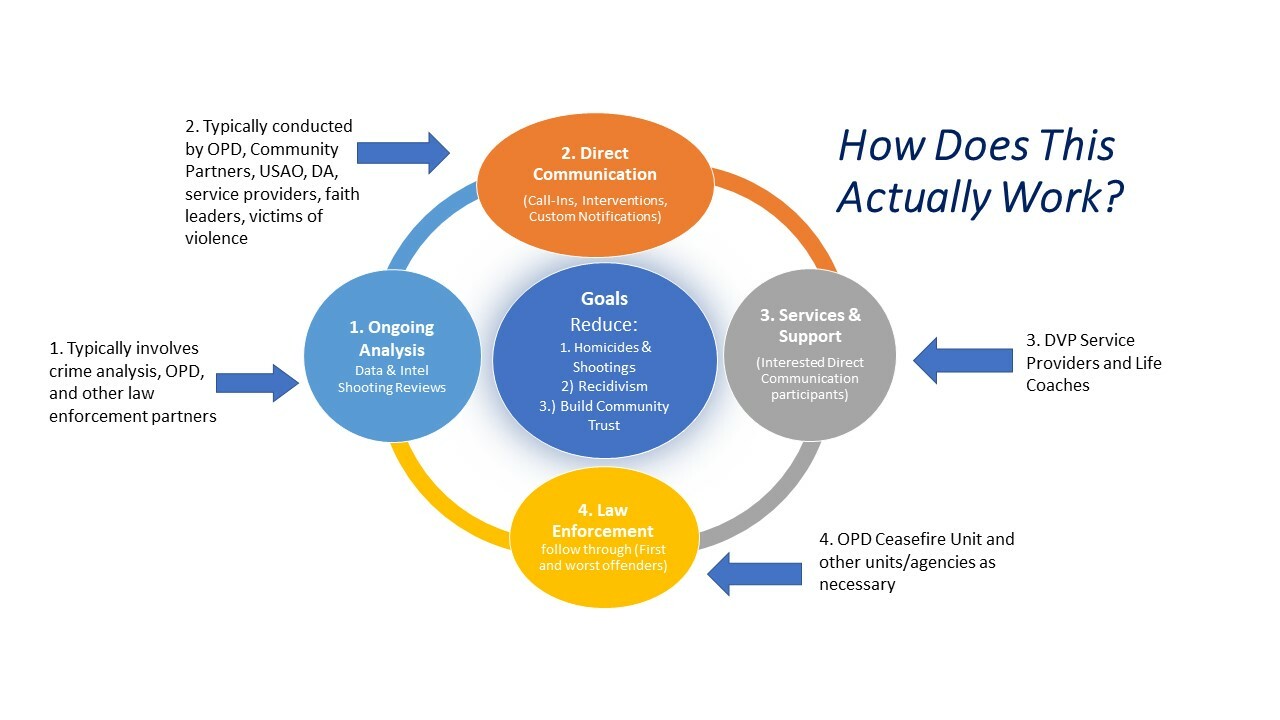Oakland Ceasefire Strategy

Resources
- Does Ceasefire Work?
- Ceasefire Services and Support
Oakland's Ceasefire
The Oakland Ceasefire Strategy has Three Goals:
- Reduce gang/group-related shootings and homicides: Ceasefire focuses on the most violent gangs/groups and individuals who are at the greatest risk of shooting or being shot. We communicate directly with individuals through large group meetings ("Call-Ins") or by meeting with them one-on-one ("custom notifications"). Ceasefire includes community outreach, services, and support and, when necessary, multi-agency law enforcement action focused specifically on gangs/groups and individuals who continue to engage in violence.
- Decrease recidivism and incarceration rates of individuals participating in the intervention: Outreach and support services are provided by the City of Oakland's Department of Violence Prevention and its network of citywide community-based direct service organizations all dedicated to helping participants by offering real alternatives, resources, advocacy, mentoring life coaching.
- Strengthen police-community relations: Vital to the success of the Ceasefire Oakland strategy are community and faith leaders. Partners like Faith In Action East Bay and the National Institution for Criminal Justice Reform provide leadership, advocacy, and resources from a community perspective that strengthen the spectrum of support for participants while pushing for mutual accountability and transparency among all partners in achieving the strategic goals.

Ceasefire History
In Oakland, data indicates that most shootings and homicides involve gang/group members. However, out of the approximately 50 violent groups in Oakland, only a small number are active at any one time and only a small subset of these groups—approximately 0.3% of the entire City's population—is at the highest risk of driving or drawing gun violence. In 2012, a group of Oakland Community Organization (OCO) pastors, alarmed by the growing number of young men of color being killed on the streets of Oakland, met with city leaders to introduce a strategy called Ceasefire. The pastors believed that a strategy that had saved so many young lives in Boston could save lives in Oakland as well. In October 2012, the Ceasefire Oakland Partnership was created by the City of Oakland and the Oakland Police Department (OPD). The Ceasefire Strategy continues as a policing approach and as a powerful anti-violence message to groups and individuals at the highest risk of gun violence.
California Partnership for Safe Communities (CPSC) is a hands-on technical advisor who worked with Oakland to develop and implement Ceasefire. CPSC's work in Oakland focused the City on reducing gun violence, reducing incarceration, improving police-community trust, and sustaining the Ceasefire strategy.
Learn More About the Ceasefire Program
Ceasefire Oakland works in collaboration with the National Network for Safe Communities at John Jay College. Our strategy is constantly informed by best practices and the help of The National Network for Safe Communities. This partnership enables Oakland and communities around the United States to adopt and implement strategies that have been proven to reduce violent crime.
- Efforts to Reduce Violent Crime Are Paying Off - an in-depth interview with Chief Whent on KCBS, July 2014
- University Now; Prevention and Control of Crime - with Captain LeRonne Armstrong, Oakland Police Dept., 2014
- Ceasefire Community Walks with Rev. Damita Davis-Howard - Jane Tyska, Oakland Tribune, 2014
- Ceasefire Partnership and Goals - Pastors of Oakland, OCO video, January 2013
- Oakland Unite "Voices" video - Young men impacted by services & support
- Oakland Finally Gets a Handle on Violent Crime - Ali Winston, Oakland Magazine, June 2016
- A Unified Theory of a Tough Town - James O'Brien, SF Magazine, June 2014
- Last Chance to Exit Street Life - Chip Johnson interviews two Ceasefire Oakland participants, SFGate, March 2014
- Steps Toward Peace; Ceasefire seen as cultural shift in Oakland - Brenda Payton, Contra Costa Times, Oct 2014
- Steps Toward Peace; Young men who are transforming their lives in Oakland - Brenda Payton, Contra Costa Times, Nov 2014
- Steps Toward Peace; Building trust between the community and the police department in Oakland - Brenda Payton, Contra Costa Times, Dec 2014
- Operation Ceasefire: Communities Tackling Crime - IIP Digital, August 2012
- Oakland Sees Biggest Drop in Homicides since 2004 - Harry Harris, Mercury News, Jan 2013
- Don't Shoot: One Man, A Street Fellowship and the End of Violence in Inner-City America, David Kennedy, Bloomsbury Press, New York, NY, 2011
- Bleeding Out by Thomas Abt - Basic Books
- David Muhammad on how CeaseFire helped cut gun violence in half in Oakland - David Muhammad speaks at the second annual Ideas We Should Steal Festival in Philadelphia, December 2019
- Oakland Ceasefire night walk: Faith leader says 'The streets belong to peace' - Drivers along International Boulevard in East Oakland waved and honked their horns in support of a ceasefire "night walk." July 2022
- Pastor asks for people to put down their guns following Oakland's 1st homicide of 2022 - Pastor Jim Hopkins asks for people to put down their guns following Oakland's 1st homicide of 2022, January 2022
- Ceasefire program aims to bring down Oakland gun violence - KRON4's Dan Thorn reports, March 2022
- Guns to gardens: How Oakland residents and a blacksmith are forging a message of peace - Azucena Rasilla, August 2022
- A Case Study in Hope - Lessons From Oakland's Remarkable Reduction in Gun Violence - Mike McLively and Brittany Nieto, April 2019
About
Ceasefire is a partnership-based, intelligence-led, and data-driven violence reduction strategy. The major goal is to reduce gang/group-related homicides and shootings. Ceasefire seeks to combine the best of community energies, social services, and strategic law enforcement to reduce gun violence associated with gangs/groups far more effectively than these entities operating alone.